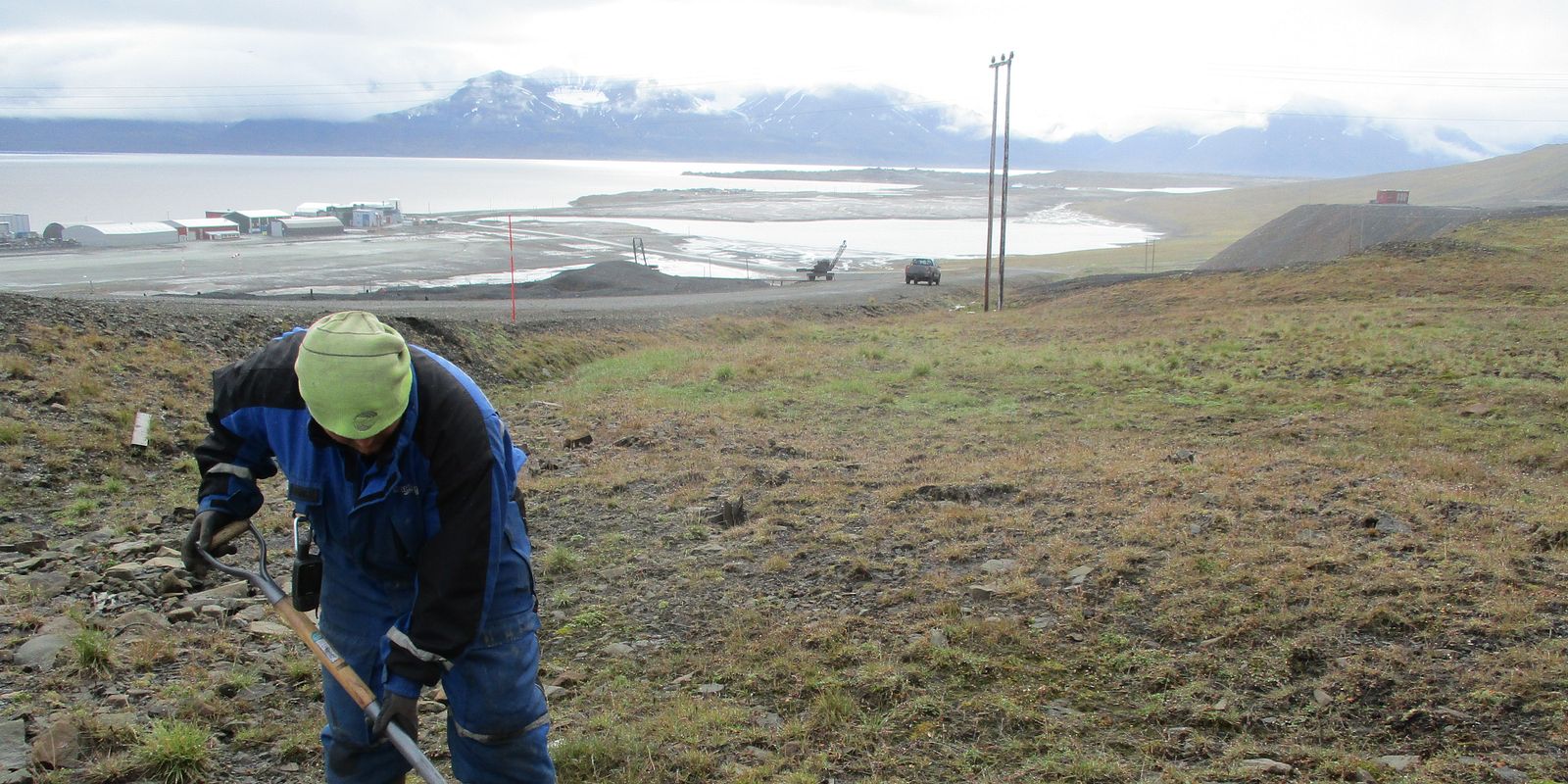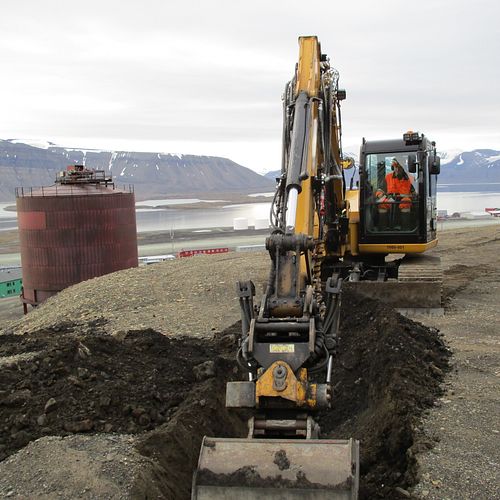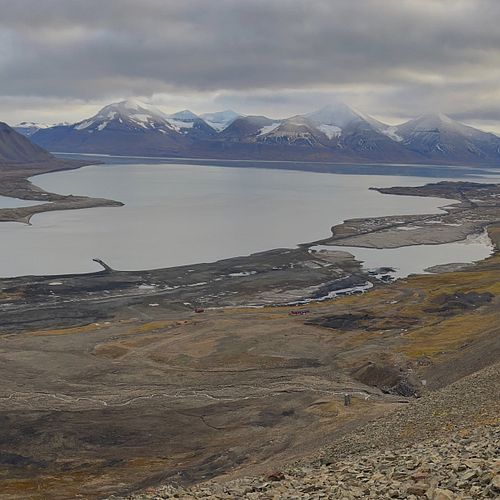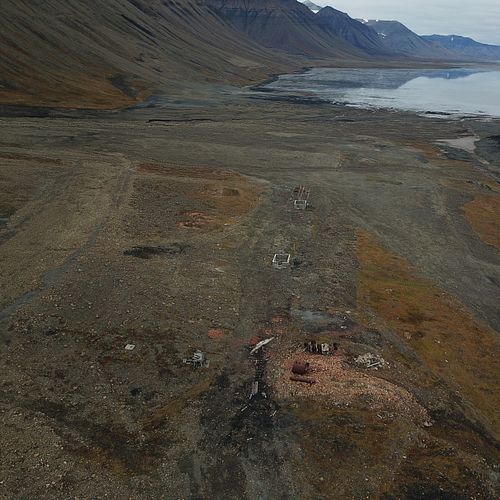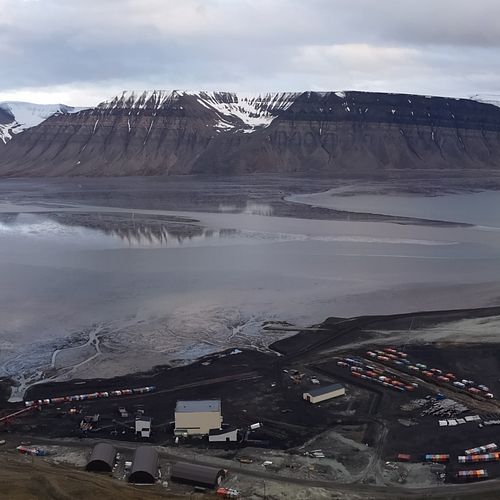30. august 2024 nyhet
By Kristine Bondo Pedersen and Anita Evenset, Akvaplan-niva
Coal mining is part of Svalbard's identity and cultural heritage, yet environmental protection laws stipulate that when industrial activities cease, the landscape must be returned to its natural state. The end of the mining epoch in Svea is a case study in balancing between nature and culture.
Coal mining operations on Svalbard trace back to the 17th century where coal deposits were found by early explorers/whale hunters. It was, however, not until 1899 that commercial mining activities commenced. Both Norway and Russia have mining activities on Svalbard, but due to exhaustion or economic conditions most of the mines were closed by 2000. Today only Barentsburg and Mine 7 are still in operation. Until 2015 it was largely unknown to which extent pollution at the coal mines had occurred and which impact this might have had on the environment. A few environmental investigations had been conducted, but these were often confined to limited areas.
As part of the green transition, the Norwegian government decided to close the coal mines, managed by Norway, on Svalbard. According to the Svalbard Environmental Protection Act, sites used for industrial purposes must be brought back to their original state at cessation. This has entailed laborious work to map and mitigate pollution at the mining sites Svea and Mine 7 to ensure that pollution of the past do not leave footprints for the future.
Is coal a source of pollution?
Coal is clearly visible in the landscape on Svalbard, and makes evidence of the coal mining heritage. But is the coal in itself a source of pollution? More than 200 samples of coal (crushed and processed) from Sveagruva, Mine 7 and the former coal storage site for Longyearbyen mines ('Hotellneset'), have been analysed for pollutants. Most of the coal samples had good environmental quality according to the Norwegian threshold values. However, in about 25% of the samples there were elevated concentrations of benzene, mercury and/or polyaromatic hydrocarbons (PAH). The samples that contained elevated concentrations of pollutants were sporadic and not from the same confined areas, and no dispersion of pollutants had occurred. Benzene and PAH are known to be bound tightly in coal particles, resulting in low mobility and bioavailability. Mercury is also bound in the coal particles, but may mobilise if acidification occurs, e.g., by oxidation of sulphides to sulfuric acid. Although the coal contains sulphides, analysis of coal from Svea revealed low potential for acidification. The coal in itself was therefore not considered to pose a risk to the environment.
Svea – a brief background for the environmental investigations
Sveagruva was a mine, with a settlement that accommodated miners, located in the innermost part of Van Mijenfjorden, approximately 44 km southeast of Longyearbyen. In the mining operation, from 1917 until 2017, several coal deposits were mined. In 2017 the Norwegian government decided to close-down the mines in Svea, meaning that the newest addition to the mine, Lunckefjell, prepared for and ready for mining a new coal deposit, never commenced the production phase. The mining company, Store Norske, managed the termination of the mine with the environmental goal of returning the area to nature. This entailed extensive work, not just for mapping and clean-up of pollution, but also demolition of buildings and infrastructure, mapping and safeguarding of cultural heritage and landscaping. Several consulting companies joined the project group to prepare an ambitious termination plan for Svea.
Svea – environmental investigations
The main objective of the environmental investigations conducted in 2018-19 was to uncover and delineate pollution found at the site, as well as to provide foundation for mitigation of pollution complying with the goal of bringing Svea back to nature. There were several potential sources of pollution in Svea, including processing plants, an oil tank farm, oil tanks for heating, workshops, power stations, landfills, sewage outlets, shooting range, storage sites, trucks, airport, and areas used for fire extinguish practices. To cover all the potential pollutants, an extensive environmental investigation was conducted, including 550 sampling points on land, 20 sediment stations, 15 water samples stations and control of three oil separators. Samples were analysed for a variety of pollutants including metals, chlorinated solvents, hydrocarbons, polychlorinated biphenyls (PCB), per- and polyfluoroalkyl substances (PFAS) and brominated flame retardants (PBDE).
The results of the environmental investigations revealed that the long period of operation had not resulted in substantial pollution, and the areas generally had good environmental quality. However, in some smaller, confined areas pollution that was assessed as posing environmental risks.
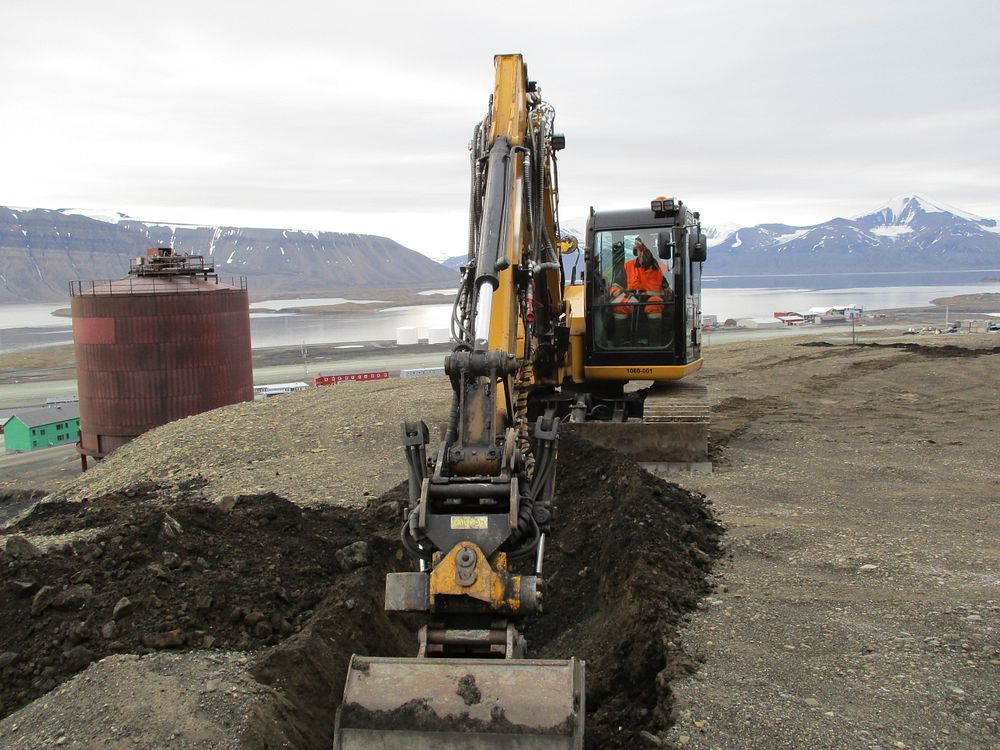
In polluted areas, more powerful soil sampling methods could be used. (Photo: Kristine B Pedersen/Akvaplan-niva).
Svea – pollution and mitigation
Pollution from a large oil spill was found on land at the oil tank farm; it was believed to have originated from a leaking tank or pipes in 1978. Although the volume was large and the concentrations high, the spilled oil mainly consisted of long-chained hydrocarbons with low mobility. Moreover, the pollution remained behind a retaining wall in the tank area. Since the pollution was stable, it did not pose a risk of dispersion to the adjacent fjord. In addition, no excavation was necessary to accommodate landscaping of the area and the oil-polluted soil could therefore remain on site. It was further stabilised by covering the whole area with clean soil.
At a landfill for household and industrial waste on Kapp Amsterdam, a PFAS pollution was discovered. The source for PFAS was fire-fighting foam that had been used for fire extinguisher practice. PFAS do not degrade or break down and are extremely persistent in both the environment and in the human body. Store Norske stopped using PFAS containing foam in the early 1990ies, but the pollution remained on Kapp Amsterdam, and had dispersed to an adjacent water stream running into the fjord. Due to a high quantity of PFAS in the soil as well as the risk of dispersion to the marine environment, mitigation actions were deemed necessary. The polluted soil was therefore excavated and transported by ship to mainland Norway for disposal at a licensed landfill.
At the temporary storage site for metal waste from the mining activities, a PBDE pollution was uncovered. The pollution originated from transport belts that had caught fire in the mine, and were temporarily stored at the site, prior to being shipped out as waste. PBDE were used as a flame retardant, but like PFAS they are persistent in the environment and the biomagnify in food chains, leading to high concentrations in top predators that are exposed. The PBDE pollution had not dispersed outside the storage site as PBDE has very low mobility and prefers to bind to particles rather than to be dissolved in water. However, due to high concentrations, high quantity, and the environmental risk related to PBDE, mitigation measures were necessary. The polluted soil was excavated and transported to mainland Norway for disposal at a licensed landfill.
All mitigation measures for removing or stabilising polluted soil in Svea were conducted in accordance with plans for shaping the landscape naturally. The clean-up of Svea finished in 2023 and apart from a few cultural heritage buildings and equipment that still remain, the footprint of the extensive mining activities is no longer visible.

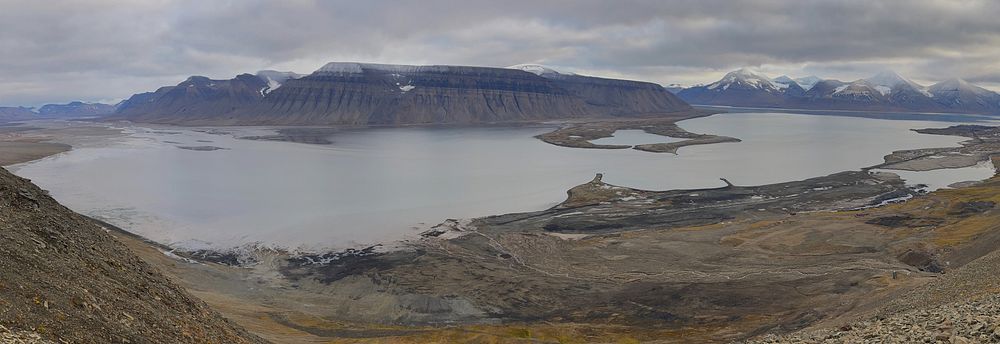
Svea in September 2019 (top) and September 2023 (bottom). (Photo: Ove Haugen/Store Norske).
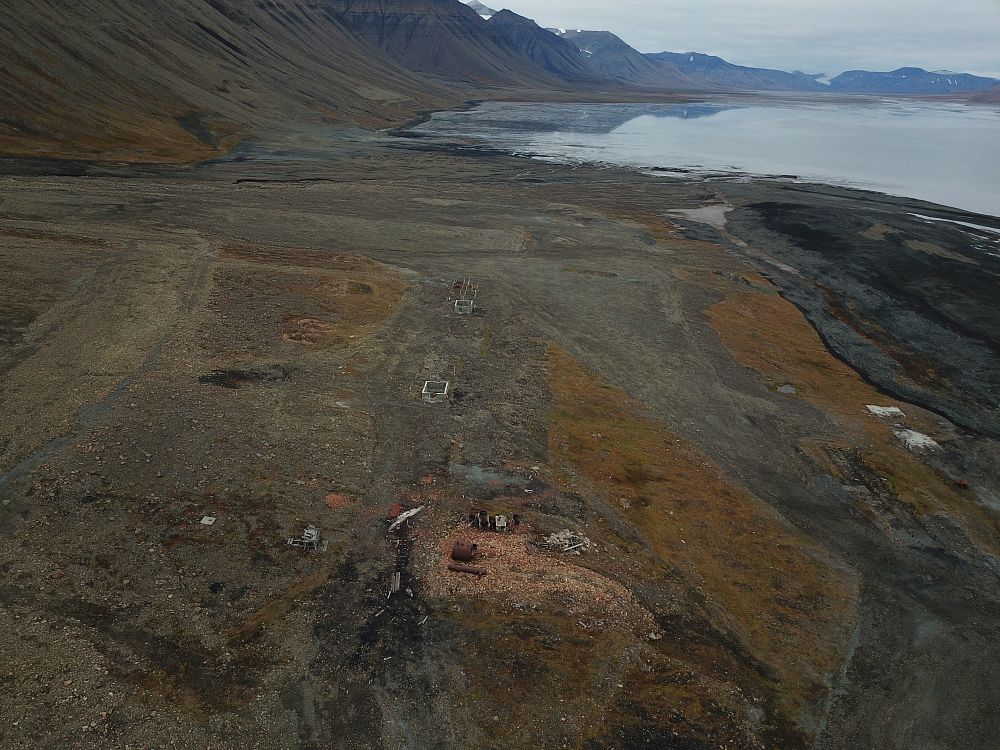
The signs of human activity that remain after the cleanup in Svea date from before 1946 and are therefore automatically protected as cultural heritage. The building foundations in the centre of this image supported barracks during the time Svea was a Swedish mining community (1917–1925). The rusty tank and scattered debris in the foreground were part of a power station. (Photo: Ove Haugen/Store Norske).
Mine 7 – environmental investigations
Mine 7 is located approximately 11 kilometres from Longyearbyen on a plateau about 380 m above sea level, between two valleys, Bolterdalen and Foxdalen. The main shaft is located 4-7 km into the mountain (Breinosa). Exploratory investigations of the mine took place in the 1960s; production started in 1976 and is still ongoing. Store Norske has decided to close the mine in 2025. The termination plan for the mine includes aspects aimed to fulfil requirements in the Svalbard Environmental Protection Act and from the authorities. However, the Governor of Svalbard has decided that some of the infrastructure related to Mine 7 is to remain as part of Svalbard’s cultural heritage, and that the site will not as a whole be restored to its original appearance. Mitigation measures in the area are largely determined by whether pollution poses a risk to the environment.
The main mining facilities (not including the underground mine) encompass approximately 85,000 m2. In this area the potential pollution sources included a processing plant (silos and sifting machine), spoil tips, fuel tank, oil separator, workshop, storage of vehicles and equipment, sewage discharge and disposal of waste. Potential pollutants hence span a wide range, including metals, hydrocarbons, benzene, PCBs, PFAS and PBDE. In 2022, environmental investigations were conducted around the main mining facilities and included collection of 491 soil samples from 160 drillings and 10 excavation pits. In addition, water and sediment were sampled at and downstream the mine site.
Despite a fairly long operational period, the soil at the mining facilities was generally relatively unpolluted. Several areas were found to be polluted with oil. These ranged in size from small (1–200 m3) to large (200–2,500 m3). However, since the amount of oil was small, its composition indicated low mobility, and the spills were already stabilised in the soil, the study concluded that the environmental risks related to the oil were small. The plan is therefore to leave most of the oil where it is. Removing the oil may entail higher environmental costs than environmental benefits.
Small amounts of oil were also found at the spoil tip. However, this area is prone to landslides, and the oil is at risk of dispersion down the mountainside. Another oil-polluted site that has been recommended for mitigation is located on the eastern plateaus used as spoil tips and for storage. The pollution is also located in a landslide-prone area, and in addition contains PBDE in concentrations above threshold values set by the Norwegian environmental authorities. For this reason, mitigation actions to remove the oil are planned, tentatively to be carried out in 2025.
In a few areas buried waste was found. This waste will be sorted and removed as part of the mitigation, tentatively in 2025.
In the mine itself, PFAS pollution has been found, originating from efforts to extinguish a fire in the 1980s. The PFAS pollution is confined to a dry area of the mine at an elevation lower than the entrance. No signs of dispersal to areas outside the mine were detected. The PFAS pollution is in part of the mine where mitigation will not be possible for health and safety reasons. When the mine closes, the area’s hydrological pathways may change; thus, PFAS-monitoring downstream of the former mining facility will be important in the years to come.
The article has previously been published in Fram Forum: https://framforum.com/2024/03/...
